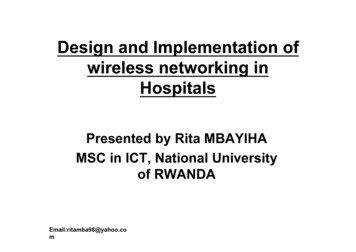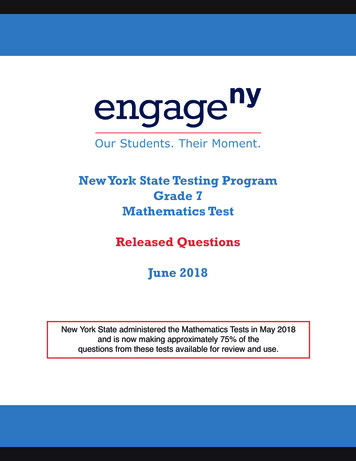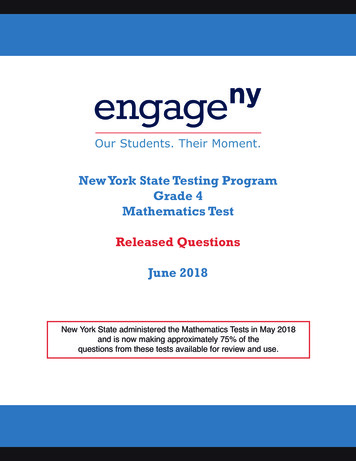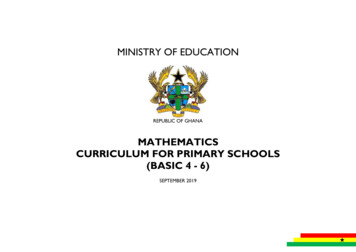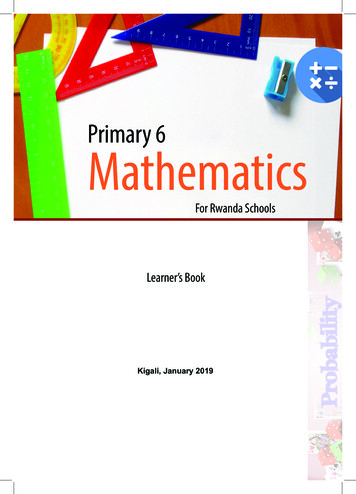
Transcription
Primary 6MathematicsFor Rwanda SchoolsLearner’s BookKigali, January 2019
Copyright 2019 Rwanda Education BoardAll rights reserved.This book is the property of Rwanda Education Board.Credit should be given to REB when the source of this book is quotedii
PrefacePrimary 6 Mathematics Book is based on the competencebased curriculum called “Curriculum for sustaineddevelopment”. This Curriculum is developed by RwandaEducation Board (REB) in 2015.Each unit is introduced with an activity to enable learnerswork and discover concepts on their own.Learners are then taken through examples, study tips andthereafter questions are given to test whether they have learntthe concept. These equip the learner with knowledge, skillsand attitude necessary to succeed in this era of technologicalgrowth and socio-economic growth.The knowledge, skills and attitudes developed will enablelearners to count, estimate, measure, calculate, handle andmanage money, interpret statistics and also represent dataon Mathematical tools such as pie-charts, bar graphs and soon.Generally, this book is organized in a way that enables thelearners to investigate, practice, summarize, integrate andfinally assess him / herself.iii
ContentsUnit 1: Reading, writing and comparing whole numbers beyond 1,000,0001.1Reading and writing numbers beyond 1,000,000 in words11.2Reading and writing numbers beyond 1,000,000 in figures31.3Finding place value and values of numbers up to 7 digits51.4Comparing numbers using , or 71.5Arranging numbers in ascending and descending order101.6Adding numbers beyond 1,000,000111.7Solving problems involving addition of numbers beyond 1,000,000 141.8Subtracting numbers beyond 1,000,0001.9Solving problems involving subtraction of numbers beyond 1,000,000 18151.10 Multiplying numbers beyond 1,000,000201.11 Solving problems using calculation strategies on multiplication211.12 Dividing numbers beyond 1,000,000221.15 Solving problems using calculation strategies on division241.14 Rounding off whole numbers to the nearest ten251.15 Rounding off whole numbers to the nearesthundred and thousand271.16 Rounding off whole numbers to the nearest ten thousands,hundred thousand and million29Unit 2: Multiplication and division of integers2.1 Multiplying integers using a number line332.2 Multiplying integers without using a number line352.3 Dividing integers using a number line362.4 Dividing integers without using a number line372.5 Solving problems involving multiplication and division of integers38iv
Unit 3: Powers and indices, LCM and GCF3.1 Indices413.2 Defining base and exponent423.3 Multiplication and the law of multiplying indices433.4 Division and the law of dividing indices443.5 Division and the law of dividing indices453.6 Finding the unknown and the law of multiplying indices463.747Finding the unknown and the law of dividing indices3.8 Finding the lowest common multiple (lcm) of numbers483.949Solving problems involving lcm3.10 Finding the greatest common factor (gcf) of numbers503.11 Solving problems involving gcf523.12 Finding the unknown number using lcm and gcf53Unit 4: Operations on fractions4.1 Multiplying a fraction by a whole number554.2 Multiplying a fraction by a whole number564.4 Solving problems involving multiplying fractions594.5 Finding reciprocals614.6 Dividing a whole number by a fraction624.7 Dividing a fraction by a whole number634.8 Dividing a fraction by a fraction644.965Solving problems involving dividing fractions4.10 Multiplying and dividing fractions66Unit 5: Rounding and converting decimals, fractions/numbers5.1Rounding off decimal numbers to the nearest tenth695.2Rounding off decimal numbers to the nearest hundredth715.35.4Rounding off decimal numbers to the nearest thousandthRounding off decimal numbers to the nearest ten thousand7273v
5.5Rounding off decimal numbers to the nearest hundred thousandth745.6 Rounding off decimal numbers to the nearest millionth755.7 Solving problems involving rounding off765.8Converting fractions into decimals775.9Converting decimals into fractions795.10 Solving problems involving converting decimals intofractions and fractions into decimals81Unit 6: Ratios, proportions, percentages and g percentages into decimalsConverting decimals to percentagesConverting percentages into fractionsConverting fractions into percentagesComparing quantities as percentagesComparing percentages as quantitiesIncreasing a given number by a given percentageDecreasing a given number by a given percentageMore about increasing and decreasing quantities by percentagesFinding the percentage increase and decreasePercentage profit and percentage lossSolving problems involving percentagesFinding ratiosSharing quantities in ratiosIncreasing and decreasing quantities in ratiosFinding the ratio of increase and decreaseSolving problems involving ratiosFinding indirect proportionsFinding the average price of a mixtureThe quantity of one type of the mixtureFinding the price of one type of ingredient in the mixtureFinding both quantities of a mixtureSolving problems involving ratios, percentages,mixtures and inverse 108109111112114115116
Unit 7: Relationship between volume, capacity and mass7.1Revision on mass measurement1197.2Revision on capacity measurement1207.3Revision on measurement of volume1227.4Finding the relationship between units of volume, capacity and mass 1237.5Converting between units of volume, capacity and mass124Unit 8: Speed, distance and time8.1 Comparing the 12-hour clock to the 24-hour clock1278.2 Converting 12-hr format to the 24-hr format1298.3 Converting 24-hr format to 12-hr format1318.4 The concept of time zones1328.5 Solving mathematical problems relating to time zones1348.6 Calculating speed1368.7 Converting speed from km/hr to m/sec1378.8 Converting speed from m/sec to km/hr1398.9141Calculating distance8.10 Calculating time1428.11 Moving bodies towards each other1438.12 Moving bodies following each other1458.13: Calculating average speed147Unit 9: Simple interest and problems involving saving9.1Calculating simple interest1519.2More about calculating simple interest1539.3Solving problems involving simple interest1549.4Calculating interest rate1569.5Solving problems involving interest rate1579.6Calculating principle1599.7Solving problems involving principal1609.8Calculating time161vii
9.9Solving problems involving time1639.10 Calculating amount1649.11 Solving problems involving amount1659.12 Saving money in the bank or putting it in investments1679.13 Solving problems involving savings169Unit 10: Equivalent expressions and number sequences10.1 Algebraic expressions17310.2 Equivalent expressions17410.3 Finding the missing consecutive numbers17510.4 Finding the missing consecutive fractions17710.5 Finding the general term/rule of a linear sequence17810.6 Finding the general term/rule of linear sequence for fractions17910.7 Finding the missing number or nth term in a linear sequence18110.8 Finding the missing fraction or nth term in a linear sequence18210.9 Finding the number sequence using the general term/rule183Unit 11: Solving simple algebraic equations and inequalities11.1 Like terms of algebraic expressions18711.2 Unlike terms of algebraic expressions18811.3 Substituting algebraic expressions with addition and subtraction 18911.4 Substituting algebraic expressions with multiplication19011.5 Substituting algebraic expressions involving division19211.6 Simple algebraic equations with one unknown19311.7 Solving fractional algebraic equations19511.8 Solving problems involving equations19711.9 Solving algebraic inequalities with one unknown19911.10 Finding the solution set20011.11 Solving problems involving simple algebraic equations201viii
Unit 12: Regular polygons and bearings12.1 Definition of polygon and their examples20512.2 Investigating the interior and exterior angles of a polygon20712.3 Investigating the sum of interior and exterior angles ofa regular polygon20912.4 Finding the interior and exterior angles of a regular polygon21012.5 Finding the sum of interior angles of a regular polygon21112.6 Exterior angles and their sum21312.7 Finding sides and apothem21512.8 Finding perimeter of regular polygons21612.9 Finding area of regular polygons21812.10 Finding bearings and compass points21912.11 Finding bearing22112.12 Tiling / construction224Unit 13: Construction of polygons and nets for cuboids and prisms13.1 Drawing triangles using a protractor and ruler22913.2 Drawing a square using a protractor and ruler23313.3 Drawing a rectangle using a protractor and ruler23413.4 Drawing a regular pentagon using a protractor and ruler23613.5 Drawing a regular hexagon23813.6 Constructing triangles using ruler and compasses24013.7 Constructing a rectangle using compasses and ruler only24313.8 Constructing a square using ruler and compasses24413.9 Finding the centre angle of a regular polygon24613.10 Constructing a regular pentagon and regular hexagon24713.11 Constructing a regular septagon and octagon25013.12 Constructing a regular nonagon and decagon25313.13 Designing nets of cuboids, cubes and prisms257ix
Unit 14Area bounded by a circle, surface area of cuboids and volume of a cylinder14.1 Finding area bounded by a circle26114.2 Calculating area of a circle using radius26314.3 Calculating area of a circle using diameter26514.4 Calculating area of a circle using circumference26614.5 Finding radius given area26814.6 Calculating the surface area of a cuboid26914.7 Finding the length of a cuboid27114.8 Finding the width of a cuboid27214.9 Finding height of a cuboid27314.10 Finding volume of a cylinder275Unit 15: Statistics15.1 Collecting data to investigate a question27915.2 Interpreting data in frequency tables28115.3 Representing data on a bar chart28315.4 Interpreting data in a bar chart28515.5 Representing data on pie charts28815.6 Interpreting data on pie charts to draw a conclusion289Unit 16: Probability16.1 Vocabulary of chance – impossible, certain, equally likely,events, chance, unlikely, likely29316.2 Using data to decide how likely something is to happen295x
Unit1Reading, writing and comparingwhole numbers beyond 1,000,000Key unit competence: To be able to read, write and compare whole numbers beyond 1,000,000.IntroductionIn daily situations, numbers are used to count, record or compare things orobjects. Big numbers beyond a million are also used in daily situation such ascounting a big sum of money in millions.(a) In your experience give other real life situations where numbers beyondmillions are used.(b) From your experience, are numbers beyond millions useful in daily life?Explain your answer.1.1 Reading and writing numbers beyond 1,000,000 in wordsActivity1. A chart shows 999,999.(a) If you add 1 to 999,999, what will be your next number?(b) How many digits will the next number have?(c) Draw an abacus with 7 spikes. Starting from ones (right), fill in thenumber you get in (a) above to the last place value on the left.(d) What is the place value of 1 in the number you get in (a) above?(e) What name would you give to the number you get in (a) above?2. Now match the number figures to their corresponding number words.2,999,999Fourteen million, one hundred fortythousand, two hundred nineteen.1,259,000Two million, nine hundred ninety-ninethousand nine hundred ninety-nine.14,140,219One million, two hundred fiftynine thousand.1
Primary 6 Mathematics Learner’s Book(a) Explain the steps you took when matching the numbers.(b) Use the same steps in (a) above to write the population of Rwanda12,279,742 in words.(c) Why is it necessary to know how to write in number words?Example 1A country has a population of 5,600,002. Write the population in words.SolutionGroup the population in digits of threes. (5),(600),(002)Draw a place value table and fill in the digits.Write in words the values in the three-digit groups below.Millions5FiveThousandsHTO600Six hundredH0UnitsT0twoO2The population is five million, six hundred thousand two.Example 2A water tank holds 82,999,555 litres of water. Write the litres in sHTOHTO999555Nine hundred ninety-nine Five hundred fifty-fiveEighty-two million nine hundred ninety-nine thousand, five hundred fifty-five litres.Study tipWhen you add 1 to 999,999, you get 1,000,000.To write 1,000,000 in words:## First group the given digits in threes starting from the right to the left sideof the whole number.## Each group of three digits is known as a period.## Draw a place value table and then write each digit under its place value.2
Unit 1: Reading, Writing and Comparing Whole Numbers Beyond 1,000,000## Write the value of each period in words. Then write the names of the periodsto separate one period from another.## Use a comma to separate millions from thousands and thousands from units.## The periods that are millions, thousands and units are written without ‘s’.So, not in plural form.Application 1.11. Write the following whole numbers in words:(a) 12,456,678(b) 9,700,956 (c) 59,648,200(d) 721,569,2162. Kalisa bought a cow at 456,700 Frw. Write the amountin words and explain your working out.3. Abeli collected 5,417,257 litres of milk from hisfarm in five months. Write the number of litres hecollected in words.4. Agatha deposited 4,565,090 Frw in the bank. Write the amount shedeposited in words.5. A non-government organisation spent 12,468,250 Frw on educatingyoung people about the dangers of alcohol. Write the amount of moneythey spent in words.6. On the inauguration ceremony of a district chairperson, 4,412,567 peoplewere invited. Write the number of people invited in words.7. A district planted 9,998,888 saplings. Write the number in words.1.2 Reading and writing numbers beyond 1,000,000 in figuresActivityMatch the following cards accordingly:Four million, five hundred sixty-fivethousand, two hundred seventy.1,900,999One million, nine hundred thousand,nine hundred ninety-nine.1,300,860One million, three hundredthousand, eight hundred sixty.4,565,2701. Explain the steps you took when matching the cards.2. Why is it necessary to know how to write numbers in figures?3
Primary 6 Mathematics Learner’s BookExample 1Write “one million, two hundred seventy thousand, one hundred thirty-six” in figures.SolutionOne million 00Two hundred seventy thousand -----------------270,000One hundred thirty-six ----------------------------1361,270,136Example 2Mahama Refugee Camp received three hundred forty-two million, six hundredtwo thousand, six hundred thirty-one Rwandan francs from the government forbuying food for the refugees in 2016. Write the amount in figures.SolutionThree hundred forty-two million342,000,000Six hundred two thousand ------602,000Six hundred thirty-one ---------------631342,602,631Study tipWhen writing whole number in figures:##########First, group the number words in threes starting from the right of the whole numbers.Write the digits of each period in numbers.Read and write each period separately.Use a comma to separate millions from thousands and units.Add the values to get the right figure.Application 1.2Write the following numbers in figures:1. Fifteen million, three hundred fifty-six thousand, four hundred thirteen.2. Eighty-three million, sixty- six thousand, two hundred thirty.3. Eight hundred million, eighteen thousand, seven hundred seventeen.4. A school collected four hundred fifty-six million, five hundred forty-fivethousand, two hundred Rwandan francs as school fees from its learners.Write the amount in figures.4
Unit 1: Reading, Writing and Comparing Whole Numbers Beyond 1,000,0005. Five hundred twelve million, five hundred forty-nine thousand Rwandafrancs was spent by a school in a year. Write the amount in figures.6. Nineteen million Rwanda francs was spent by a company to print books.Write the amount in figures.1.3 Finding place value and values of numbers up to 7 digitsActivity1. Look at the cards below and form a number.78305912. Draw a place value table in your exercise book.3. Fill in the digits of the number 7,830,591 in the correct place values inthe place value table.4. Write down the place value of each digit from the table.5. Use the place value table to write 7,830,591 in words.6. In which areas of your life can you apply place values?Example 1What is the place value of each digit in 8,356,421?SolutionMethod 1Count the digits in the number. There are 7 digits, now draw a place value tableas shown below.PeriodMillionsThousandsUnitsPlace value H TOHTOHTONumber83564218 x 1,000,000 3 x 100,000 5 x 10,000 6 x 1,000 4 x 100 2 x 10Value 8,000,000300,00050,000The place value of 8 is millions.The place value of 3 is hundred thousands.The place value of 5 is ten thousands.The place value of 6 is thousands.The place value of 4 is hundreds.The place value of 2 is tens.The place value of 1 is ones.56,000400201x11
Primary 6 Mathematics Learner’s BookMethod 28, 3 5 6, 4 2 1OnesTensHundredsThousandsTen thousandsHundred thousandsMillionsExample 2What is the value of 8 in 4,835,634?SolutionsPeriodMillionsPlace value H TNumberThousandsUnitsOHTOHTO83564214 x 1,000,000 8 x 100,000 3 x 10,000 5 x 1,000 6 x 100 3 x re the value of 8 is 800,000.Study tip## The place values of numbers are the positions of Ones, Tens, Hundreds,Thousands, Ten thousands, Hundred thousands, Millions, Ten millionsand Hundred millions.## To find the place values of digits, draw the place value table and place thedigits in it from the right.## To find the value of digits, find the product of the digits and their place values.Application 1.31. Write the place value of each digit in the following:(a) 2,312,983 (b) 7,676,405(c) 10,101,899 (d) 853,925,7322. Write the place value of the underlined digits in the following:(a) 3,459,874 (b) 356,295,712 (c) 7,879,631(d) 54,382, 3453. Write the value of each digit in the following:(a) 24,567,400 (b) 894,500,678 (c) 208,567,120 (d) 120,394,4564. Write the value of the underlined digits in the following:(a) 34,475,576 (b) 687,034,239 (c) 126,687,893 (d) 653,592,7215. Describe how you can identify the value of 6 in 4,567,890.6
Unit 1: Reading, Writing and Comparing Whole Numbers Beyond 1,000,0001.4 Comparing numbers using , or Activity1. Study the figure below and answer the questions that follow.(a)(b)20kg of rice15kg of beans(a) Which one is bigger than the other?(b) Explain your answer.(c) Complete the sentence using either , or . That is A . B.2. Count the total number of learners in your class.(a) Use , or to compare the number of boys to girls in your class.(b) How can you apply comparison in your daily life situations?Example 1Compare 6,312,542 and 6,312,452 using , or .SolutionDraw a place value table and fill in the Compare the digits in each place value from left to right.6 6, 3 3, 1 1, 2 2, 5 4 in the hundreds of units place value.Therefore, 6,312,542 6,312,4527O22
Primary 6 Mathematics Learner’s BookExample 2Compare 42,635,989 and 42,543,129 using , or .SolutionDraw a place value table and fill in the 82O99Compare the digits in each place value from left to right.4 4, 2 2, 6 5 in the hundred thousands place value.Therefore, 42,635,989 42,543,129.Example 3Imanirere sold clothes worth 2,560,320 Frw in 2015. She sold clothes worth4,576,670 Frw in 2016. Compare the sales over the two years using , or .SolutionDraw a place value table and fill in the O00Compare the digits in each place value from left to right.2 4 in the millions place value.Therefore 2,560,320 4,576,670Study tip## The symbol means greater than, means less than and means equal to.## Compare numbers using place values. Check the biggest number againstthe smallest number.## You can compare numbers by counting the number of digits of the wholenumbers given.8
Unit 1: Reading, Writing and Comparing Whole Numbers Beyond 1,000,000## For numbers with the same number of digits, compare the digits with thesame place value from the left. The number with the bigger digit is greaterthan the other. The number with the smaller digit is less than the other.## For numbers with a different number of digits, the one with the highestnumber of digits is greater than the one with the lowest number of digits.## If two numbers have different place values, compare them looking for thebiggest or the smallest.## If two numbers have the same place values and the same number of digits,compare them starting from the left until you get two different digits to tellthe biggest or the smallest number.Application 1.41. Use , or to compare the following:(a) 260,340 60,430,730.(b) 8,855,631 .8,855,136(c) 302,831,547 30,283,154.(d) 9,991,999 9,991,9992. Camille harvested 5,562 tonnes of beans and Kajileharvested 5,256 tonnes of beans. Who harvestedmore beans?3. Mukagasana deposited 2,506,590 Frw in the bank.His son deposited 259,000 Frw. Who depositedmore money? Explain your answer.Sacks of beans4. A school received a donation of 67,957,800 Frw while another schoolreceived 67,854,590 Frw. Find the difference. Which school receivedless money?5. Hospital A admitted 45,679 patients in 2016while hospital B admitted 67,890 patientsin the same year. Which hospital admittedmore patients? Explain your answer.6. A district collected 4,853,825 Frw in taxeswhile another district collected 4,197,900Frw. Which district collected more money?9Patients in the hospital.
Primary 6 Mathematics Learner’s Book1.5 Arranging numbers in ascending and descending orderActivityUse cards below.942,704 942,4071,496,0661,496,606Order pairs of cards in ascending order.Write the order on slips of paper.Change to ordering cards in descending order.Write down the order.What did you consider when ordering the numbers in the cards? Explain yourprocedure to the class.ExampleArrange the following numbers in ascending and descending Use a place value table to compare the sH0544T5544O5066 Start comparing from the highest place value to the lowest place value. In ones of millions, 1 1, 3 3, but 1 3 and 3 1. In hundred thousands, 7 7, 0 2, so, 3,205,446 3,025,446; 3,025,446 1,770,550; 1,770,550 1,707,055. Also, 1,707,055 1,770,550; 1,770,550 3,025,446 and 3,025,446 3,205,444. Ascending order is the arrangement from the smallest to the biggest. So,the ascending order is 1,707,055; 1,770,550; 3,025,446; 3,205,446. Descending order is the arrangement from the biggest to the smallest. So,the descending order is 3,205,446; 3,025,446; 1,770,550; 1,707,055.10
Unit 1: Reading, Writing and Comparing Whole Numbers Beyond 1,000,000Study tip## A number is greater than another if its corresponding digit of another numberin the same place value is smaller if they have the same number of digits.## A number is smaller than another if its corresponding digit of anothernumber in the same place value is bigger.## A number with more digits is bigger than the other.## A number with fewer digits is smaller than the other.## Use a place value table to compare and arrange numbers in ascendingand descending order.Application 1.51. Order the following numbers in ascending order.(a) 1,673,421; 1,065,345; 1,671,241; 1,065,234(b) 2,303,874; 2,033,874; 2,330,874; 2,874,303(c) 9,827,623; 6,827,623; 8,279,625; 9,623,829(d) 11,046,305; 11,460,305; 4,116,305; 4,611,5302. Order the following numbers in descending order.(a) 4,963,427; 4,427,963; 4,369,427; 4,724,963(b) 8,306,396; 8,693,306; 8,369,306; 8,063,963(c) 12,042,994; 12,420,994; 12,994,609; 12,499,906(d) 3,625,113; 625,113; 6,253,311; 652,3111.6 Adding numbers beyond 1,000,000Activity Write two 7-digit numbers on flash cards. Arrange them in vertical order by the place value of their digits. Work out their sum. What answers do you get? Compare the answers in your groups.11
Primary 6 Mathematics Learner’s BookExample 1Add: 6,325,904 and 2,834,978.SolutionArrange the digits according to place values.Then add the two whole numbers starting from the right (ones) to the left.MillionsHT s Add ones: 4 8 12. Write 2 under ones and carry 1 to tens. Add tens: 0 7 1 8. Write 8 under tens. Add hundreds:9 9 18. Write 8 under hundreds and carry 1 to thousands.Thousands Add thousands: 5 4 1 10. Write 0 under thousands and carry 1 toten thousands. Add ten thousands: 2 3 1 6. Write 6 under ten thousands. Add hundred thousands: 3 8 11. Write 1 under hundreds thousandsand carry 1 to millions.Millions Add Millions: 1 6 2 9 write 9 under millions.Therefore, 6,325,904 2,834,978 9,160,882.Example 2Find the sum of 4,629,208; 2,823,004 and 5,987,253.SolutionArrange the digits according to place values.Then add the two whole numbers starting from the right (ones) to the left.MillionsHT 6O8435
Unit 1: Reading, Writing and Comparing Whole Numbers Beyond 1,000,000Units: Add ones: 8 4 3 15. Write 5 under ones and carry 1 to tens. Add tens: 0 0 5 1 6. Write 6 under tens. Add hundreds: 2 0 2 4. Write 4 under hundreds.Thousands: Add thousands: 9 3 7 19. Write 9 under thousands and carry 1 toten thousands.Add ten thousands: 2 2 8 1 13. Write 3 under ten thousands andcarry 1 to hundred thousands.Add hundred thousands: 6 8 9 24. Write 4 under hundred thousandsand carry 2 to millions.Millions: Add millions: 4 2 5 2 13. Write 3 under millions and carry 1to ten millions. Therefore, 4,629,208 2,823,004 5,987,253 13,439,465Study tip## When adding whole numbers, start from right to left. That is, from ones, totens, thousands, ten thousands, hundred thousands and millions.## Words used for addition include; total, sum, altogether, combined.Application 1.6Add the following:(a) 4,985,670 2,322,502 (b) 2,069,012 2,625,044 (c) 6,232,343 2,432,234 1,067,103 (d) 3,807,233 2,067,943 6,723,623 (e) 9,088,033 9,000,046 (f)1,602,444 2,622,433 5,789,987 (g) 8,421,982 3,723,848 3,921,982 13
Primary 6 Mathematics Learner’s Book1.7 Solving problems involving addition of numbers beyond 1,000,000ActivityIn a country, there are 12,000,000 males and 3,000,000 females.1. What should you do to know the total number of people in the country?2. Compare the number of males to that of females.3. Create a list of instances where addition is applied in your daily life.4. How is addition relevant to you?ExampleBuilders used 5,762,426 bricks to build the foundation of a house and 3,028,987bricks to put up walls of the house. Find the total number of bricks that wereused to complete the house.SolutionArrange the digits according to place values.Then add the two whole numbers starting from the right (ones) to the left.MillionsHT O538ThousandsHT760279O281UnitsH494T281O673Units Add ones: 6 7 13. Write 3 under ones and carry 1 to tens. Add tens: 2 8 1 11. Write 1 under tens and carry 1 to hundreds. Add hundreds: 4 9 1 14. Write 4 under hundreds and carry 1 to thousands.Thousands Add thousands: 2 8 1 11. Write 1 under thousands and carry 1 toten thousands. Add ten thousands: 6 2 1 9. Write 9 under ten thousands. Add hundred thousands: 7 0 7. Write 7 under hundreds thousands.Millions Add Millions: 5 3 8 write 8 under millions.The total bricks that were used to complete the house are 8,791,413.14
Unit 1: Reading, Writing and Comparing Whole Numbers Beyond 1,000,000Study tip## First read and interpret the question correctly.## When adding whole numbers, arrange the digits in the tableaccording to place values.## If numbers do not have the same number of digits, use zeros to act as placeholders to ensure proper alignment of each digit according to place values.## Start adding from right to the left, that is from ones to tens, thousands, tenthousands, hundred thousands and millions.## Other words used for addition include total, sum, altogether and combined.Application 1.71. A dairy cooperative sold 1,123,456 and 8,467,619 litres of milk on Mondayand Tuesday respectively. How much milk was sold in the two days?2.Publishing companies A, B and C supplied the following number of textbooksto primary schools in the same district last month. A supplied 1,345,346copies, B supplied 1,206,460 copies and C supplied 1,600,400 copies. Whatis the total number of books supplied by all three publishing companies?3. 3,460,782 people participated in a Run for Water marathon organisedby a telecom company. About 5,525,448 people participated in a cancermarathon organised by the same telecom company. How many peopleparticipated in both marathons?4.Kayitesi sold 1,625,255 kg of maize flour in one year and 3,268,450 kgof maize flour in another year. What was her total sales in the two years?1.8 Subtracting numbers beyond 1,000,000Activity Write two 7-digit numbers on slips of paper.Calculate the difference between the bigger and the smaller number.What is the most suitable method you can use to work out the difference?Explain your procedure to the class.Now try out this: Mukangarambe went to the shop with 20,000 Frw,she spent 17,240 Frw. How much was her balance?15
Primary 6 Mathematics Learner’s BookExample 1Subtract: 6,345,625
iv v Contents Unit 1: Reading, writing and comparing whole numbers beyond 1,000,000 1.1 Reading and writing numbers beyond 1,000,000 in words 1 1.2

